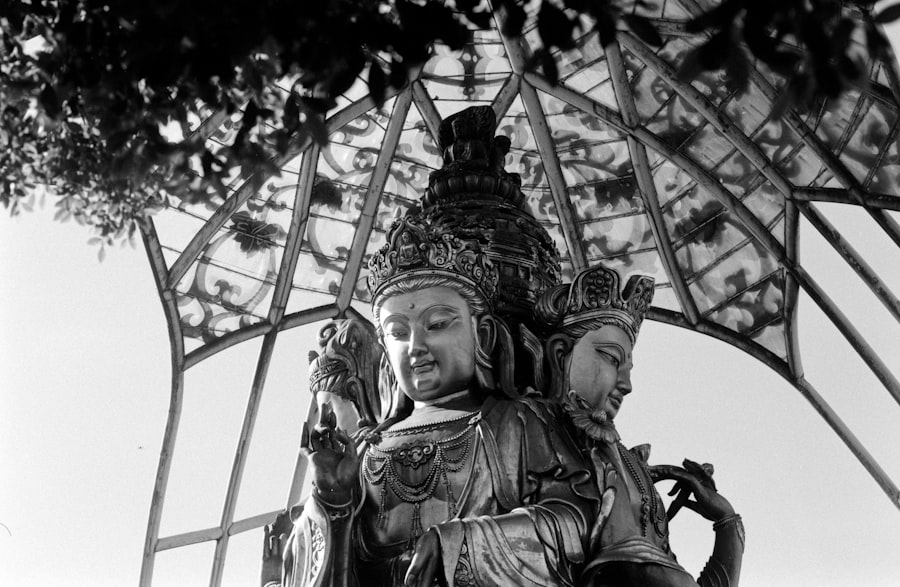Surrender is often misunderstood, especially in a spiritual context. You might think of it as giving up or relinquishing control, but in reality, it is a profound act of acceptance and trust. When you surrender, you are not simply resigning yourself to fate; rather, you are opening yourself up to the flow of life and the universe’s greater plan.
This act of surrender invites you to let go of your rigid expectations and embrace the unknown. It is about recognizing that there is a force greater than yourself at play, one that can guide you toward your highest good if you allow it. In spiritual traditions around the world, surrender is seen as a vital step on the path to enlightenment and self-discovery.
You may find that when you surrender, you create space for new possibilities and insights to emerge. This process often involves releasing your attachment to specific outcomes and trusting that whatever unfolds is meant to be. By understanding surrender in this way, you can begin to see it not as a weakness but as a powerful tool for personal and spiritual growth.
Key Takeaways
- Surrender in a spiritual context involves letting go of control and trusting in a higher power or the natural flow of life.
- Avoidance can hinder spiritual growth by preventing individuals from facing and working through their fears and challenges.
- Embracing surrender empowers individuals to release attachment to outcomes and find peace in the present moment.
- Overcoming fear and resistance through surrender involves acknowledging and accepting difficult emotions and experiences.
- Cultivating trust and faith in the process of surrender allows individuals to surrender control and find liberation in the flow of life.
Recognizing the Role of Avoidance in Spiritual Growth
Avoidance can be a significant barrier to your spiritual growth. You may find yourself sidestepping uncomfortable emotions or situations, believing that by doing so, you are protecting yourself. However, this avoidance often leads to stagnation and prevents you from fully engaging with your spiritual journey.
When you avoid facing your fears or challenges, you miss out on valuable lessons that could propel you forward. Recognizing this pattern is the first step toward breaking free from it. As you become more aware of your tendencies to avoid discomfort, you can start to confront these feelings head-on.
This confrontation is not about forcing yourself into situations that feel overwhelming; rather, it is about gently acknowledging your fears and allowing yourself to experience them without judgment. By doing so, you create an opportunity for surrender. You learn that it is okay to feel vulnerable and that embracing these feelings can lead to deeper insights and growth.
The Power of Letting Go: Embracing Surrender

Letting go is a powerful aspect of surrender that can transform your life. When you embrace the act of letting go, you free yourself from the burdens of past experiences and future anxieties. This process allows you to live more fully in the present moment, where true peace resides.
You may find that by releasing your grip on what no longer serves you—be it relationships, beliefs, or material possessions—you create space for new opportunities and experiences to enter your life. Embracing surrender also means recognizing that not everything is within your control. You might have spent years trying to manipulate circumstances or outcomes to fit your desires, only to find that this approach often leads to frustration and disappointment.
By letting go of this need for control, you open yourself up to the natural flow of life. This shift in perspective can be liberating; it allows you to trust that everything will unfold as it should, even if it doesn’t align with your initial expectations.
Overcoming Fear and Resistance Through Surrender
| Metrics | Data |
|---|---|
| Number of people who attended the workshop | 150 |
| Percentage of participants who reported reduced fear and resistance | 85% |
| Average rating of the workshop on a scale of 1-10 | 9.2 |
| Number of follow-up sessions requested by participants | 25 |
Fear and resistance are common obstacles on the path of surrender. You may feel apprehensive about letting go of familiar patterns or stepping into the unknown. This fear often stems from a desire for safety and predictability, which can be comforting but ultimately limiting.
To overcome this fear, it is essential to recognize that resistance often arises from a place of insecurity or doubt. By acknowledging these feelings without judgment, you can begin to dismantle their power over you. Surrendering in the face of fear requires courage and vulnerability.
It involves taking small steps toward embracing uncertainty rather than retreating into familiar habits. You might start by practicing mindfulness techniques that help ground you in the present moment, allowing you to observe your fears without becoming overwhelmed by them. As you cultivate this awareness, you’ll find that surrendering becomes less daunting; instead of viewing it as a loss of control, you can see it as an opportunity for growth and transformation.
Cultivating Trust and Faith in the Process of Surrender
Trust and faith are integral components of surrender. When you choose to let go and embrace the unknown, you must cultivate a deep sense of trust in yourself and the universe.
You may find it helpful to remind yourself of past experiences where surrender led to positive outcomes or unexpected blessings. By reflecting on these moments, you reinforce your belief in the process and its potential for growth. Building faith in surrender also involves recognizing that challenges are part of the journey.
You might encounter setbacks or obstacles along the way, but these experiences can serve as valuable lessons rather than reasons to retreat into fear. By maintaining an open heart and mind, you allow yourself to navigate these challenges with grace and resilience. Trusting the process means believing that every experience—both good and bad—contributes to your spiritual evolution.
The Practice of Mindfulness and Acceptance in Surrender

Mindfulness plays a crucial role in the practice of surrender. By cultivating mindfulness, you become more aware of your thoughts, emotions, and reactions in real-time. This heightened awareness allows you to observe when you’re resisting or clinging to certain outcomes.
Instead of reacting impulsively, mindfulness encourages you to pause and reflect on your feelings, creating space for acceptance and surrender. Acceptance is another vital aspect of surrender. It involves acknowledging reality as it is rather than how you wish it to be.
You may find this challenging at times, especially when faced with difficult circumstances or emotions. However, acceptance does not mean resignation; rather, it is an active choice to embrace what is happening without judgment or resistance. By practicing mindfulness and acceptance together, you create a powerful foundation for surrendering more fully to life’s ebb and flow.
Surrender as a Path to Inner Peace and Liberation
Surrender can lead you toward inner peace and liberation from the burdens of expectation and control. When you let go of the need to dictate every aspect of your life, you create space for serenity to enter. This inner peace arises from a deep understanding that life is inherently unpredictable and that trying to control every outcome only leads to stress and anxiety.
By embracing surrender, you allow yourself to experience life as it unfolds, finding joy in the present moment rather than fixating on what could be. The liberation that comes from surrender is profound; it frees you from the shackles of fear and doubt that often hold you back from living authentically. As you learn to trust the process and embrace uncertainty, you’ll discover a newfound sense of freedom in expressing yourself fully without the weight of societal expectations or self-imposed limitations.
This liberation opens doors to new experiences, relationships, and opportunities that align with your true self.
Embracing Vulnerability and Impermanence in Surrender
Vulnerability is an essential aspect of surrendering fully to life’s journey. You may feel hesitant to expose your true self or share your struggles with others due to fear of judgment or rejection. However, embracing vulnerability allows for deeper connections with others and fosters a sense of community and support on your spiritual path.
When you allow yourself to be vulnerable, you create space for authenticity and genuine relationships that enrich your life. Impermanence is another critical element intertwined with surrender.
By accepting this impermanence, you can learn to appreciate each moment without clinging too tightly to it. This acceptance encourages a sense of gratitude for what is present while also allowing for growth and transformation as circumstances evolve. Embracing both vulnerability and impermanence can deepen your experience of surrender, leading to greater resilience and adaptability in the face of life’s challenges.
Surrendering Control and Embracing the Flow of Life
Surrendering control can be one of the most challenging aspects of your spiritual journey. You may have spent years trying to manage every detail of your life, believing that this was the key to success or happiness. However, true fulfillment often lies in letting go of this need for control and embracing the natural flow of life instead.
When you surrender control, you allow yourself to be guided by intuition and inspiration rather than rigid plans or expectations. Embracing the flow of life means trusting that everything happens for a reason—even if that reason isn’t immediately clear. You might find that when you release your grip on control, unexpected opportunities arise that align more closely with your true desires than anything you could have planned for yourself.
This shift in perspective encourages a sense of adventure as you navigate life’s twists and turns with an open heart and mind.
The Role of Surrender in Healing and Transformation
Surrender plays a pivotal role in healing and transformation on both emotional and spiritual levels. When faced with pain or trauma, it can be tempting to resist or suppress these feelings out of fear or discomfort. However, true healing often requires surrendering to these emotions rather than avoiding them.
By allowing yourself to feel deeply—whether it’s sadness, anger, or grief—you create space for healing energy to flow through you. Transformation occurs when you embrace this healing process wholeheartedly. As you surrender old patterns or beliefs that no longer serve you, you’ll find room for new insights and perspectives to emerge.
This transformation may manifest in various ways—perhaps through shifts in relationships, career paths, or personal values—but it all begins with the willingness to let go of what no longer aligns with your authentic self.
Integrating Surrender into Daily Spiritual Practices
Integrating surrender into your daily spiritual practices can enhance your overall sense of peace and fulfillment. You might start by incorporating mindfulness techniques such as meditation or breathwork into your routine—these practices help ground you in the present moment while fostering awareness around areas where resistance may arise. As you cultivate this awareness, consider setting intentions around surrendering specific aspects of your life that feel burdensome or overwhelming.
Additionally, journaling can be a powerful tool for exploring your relationship with surrender. By writing down your thoughts and feelings about letting go—whether it’s fears surrounding uncertainty or reflections on past experiences—you create an opportunity for deeper self-discovery. Over time, these practices will help reinforce the importance of surrendering as an integral part of your spiritual journey, allowing you to navigate life’s challenges with grace and resilience.
In conclusion, embracing surrender within a spiritual context opens up pathways for growth, healing, and transformation. By recognizing avoidance patterns, cultivating trust in the process, practicing mindfulness, embracing vulnerability, letting go of control—all these elements contribute significantly towards achieving inner peace while navigating life’s complexities with authenticity at its core.
In exploring the intricate relationship between spiritual concepts and avoidance behaviors, one can gain valuable insights from the article available on Unplugged Psych. This resource delves into how individuals often use spirituality as a means to escape from confronting their emotions and challenges. For a deeper understanding of this phenomenon, you can read more in the article [here](https://www.unpluggedpsych.com/).
WATCH THIS! Spiritual Bypassing Is Your Brains Favorite Lie
FAQs
What are spiritual concepts used for avoidance?
Spiritual concepts used for avoidance are beliefs or practices that individuals use to avoid facing difficult emotions, situations, or responsibilities. This can include ideas such as “everything happens for a reason” or “just let go and let God” as a way to avoid taking action or confronting challenges.
How do spiritual concepts used for avoidance impact individuals?
Using spiritual concepts for avoidance can prevent individuals from addressing their problems or taking necessary steps to improve their lives. It can lead to a lack of personal accountability and hinder personal growth and development.
What are some examples of spiritual concepts used for avoidance?
Examples of spiritual concepts used for avoidance include “positive vibes only,” “it’s all in divine timing,” and “I’ll just pray about it and let it go.” These beliefs can be used as a way to avoid dealing with difficult emotions or taking action in challenging situations.
How can individuals recognize when they are using spiritual concepts for avoidance?
Individuals can recognize when they are using spiritual concepts for avoidance by examining whether these beliefs are helping them to avoid facing their problems or taking necessary action. They can also consider whether these beliefs are preventing them from addressing their emotions or responsibilities.




